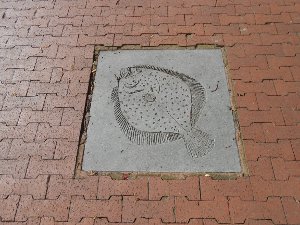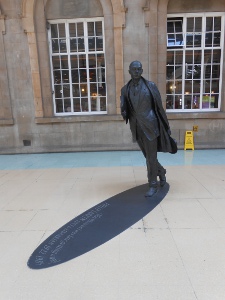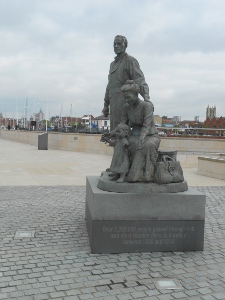 Marina Near Our Hotel
Marina Near Our Hotel
People would say to us, "why do you want to go to Hull?" because it is definitely not a well-known tourist destination. But it was a center for emigrants to the United States and elsewhere during the nineteenth century, including several families of our own ancestors, so we felt connected to it.
 Marina Near Our Hotel
Marina Near Our Hotel
We almost didn't get to Hull -- or at least not easily. Even though we have taken lots of buses, each trip has its own character. This bus left from the largest Manchester station. We reached the station early, had lunch and waited and waited. Our bus was not announced, and then suddenly it was boarding. We had to push our way through queues of people waiting to board other buses just to reach our platform and then we thought we'd get smart and short-cut it through the local bus terminal but there was no way around so we had to retrace our steps and then we got to our bus as the last passengers just before the driver was going to pull out.
It was a two-part trip involving a change at Leeds. The second bus was a local, getting off the freeway many times on the way from Leeds to Hull (which should be only 45 minutes on the motorway). We knew something bad was happening when the coach stopped along the motorway; after a while it started up again. We were sitting over the transmission and could hear the gears grinding. It started happening with more frequency, and the bus kept going slower and slower until finally we stopped at the side of a road.
"Sorry folks the coach is broken again - it was broken like this two days  Part of the Hull Waterfront
ago and they just patched it up to get it back on the road - I've called for another bus to come out from Hull - about twenty minutes."
Part of the Hull Waterfront
ago and they just patched it up to get it back on the road - I've called for another bus to come out from Hull - about twenty minutes."
One man wearing a jacket and tie sat inside the stifling bus complaining steadily, but eventually the rest of us stood outside under the shade of a tree where there was a nice breeze. A kindly passenger went back into the bus and returned with a daypack containing a water bottle, which he emptied into a makeshift plastic dish so the very large but polite young German Shepherd could have a drink -- they do have such heavy coats! Then after a bit another bus showed up and we made a point of thanking the driver of the first bus and telling him we were sorry his coach had broken down. Finally the grouchy man got off the broken bus and on the replacement, muttering all the time.
In Hull they have placed the bus station right next to the train station and called the whole thing "Hull Paragon Interchange." We were at the far end of it and wrestled our three suitcases into marching order and left Paragon and across the street and down several blocks and across the A63 (good thing the Brits provide safe crossings for pedestrians) and down a block and around the  A Sidewalk Turbot
corner to the Holiday Inn Hull Marina. We felt even better when we strolled a block to the Kingston Shopping center and found some goodies to take up to the room. We have a nice firm bed, an excellent bath, carpeted floors and daily service, which we plan to thoroughly enjoy.
A Sidewalk Turbot
corner to the Holiday Inn Hull Marina. We felt even better when we strolled a block to the Kingston Shopping center and found some goodies to take up to the room. We have a nice firm bed, an excellent bath, carpeted floors and daily service, which we plan to thoroughly enjoy.
Next day, Fish Day! The city of Hull has installed life-size (!) plaques of local fish along the sidewalks of Old Town, and provided a convenient map for locating the plaques and checking them off. It's one of several maritime connections to the city. Additional maritime notes include various anchors, bollards, flags, and, in one stretch of pavement, a list in order of the many different sails and spars which can be found on a fully rigged sailboat. In the middle of our walk we spotted the statue of a man facing out to sea; it commemorates the settlement of the codfish wars with Iceland.
We started at the hotel, and walked along Castle Street past the retired lightship Spurn. It used to sit outside the mouth of the Humber River, a very tricky waterway for ships to navigate, with narrow channels, islands, and sand bars. Double-hulled, it was built to withstand the occasional nudge from a passing ship. With power only for the light and domestic purposes, it was towed  The Small Eel
into position, securely anchored, and rode for two months until the relief crew came. The crew was instructed to make the supplies last until that time.
The Small Eel
into position, securely anchored, and rode for two months until the relief crew came. The crew was instructed to make the supplies last until that time.
We saw plaques for starfish, mussel, warty doris, swordfish, quid, viviparous blenny, yawling, haddock, umber, ray, turbot, naucrates ductor, garfish, icefish, eel, shrimp, whitebait, electric eel, sea trout, lumpsucker, john dory, brill, gurnard, squid, oarfish, hake, monkfish, shark, zander, and x-ray fish. A friendly Hull policeman told us the salmon plaque had been pinched; we noticed several eels had been detached from the boardwalk planks, but the ones set into stone have lasted longer.
Round about lumpsucker we met a man from Llandudno, Wales, who originally hailed from the East Ridings of Yorkshire, and was in Hull today, as he has been every year since he was 14, to hear his brother ring the changes at St. Mary's, the largest parish church in England. He was also a genealogist, past president of the family history society for Northwestern Wales, and we shared lots of historical information.
Scarborough
 The Steps To Oceanside
The Steps To Oceanside
It seemed reasonable to head for the seaside, and what could be better than a train route which took us through Cottingham, Beverley, Arram, Hutton Cranswick, Driffield, Nafferton, Bridlington, Bempton, Hunmanby, Filey, Seamer and, finally, Scarborough? and all of these in about an hour and a half.
Disembarking, we walked along a street lined with shops which perhaps offered more holiday items (sand pails, sunscreen, and rock candy) than the typical village. When we spotted a set of steep old steps we headed down and found ourselves in a totally different Scarborough. A broad beach with beautiful fine sand was already filling up with toddlers bearing shovels and buckets and lining up for the donkey rides. Here the shops sold fresh seafood snacks, more candy, ice cream, and you can imagine the rest.
Scarborough was the first of the English seaside resorts to become popular, quickly followed by Blackpool and Brighton and so many others. It has had its ups and downs, and some of the 19th century hotels are being restored now, but it is a vibrant, busy, family-friendly day-trip beach area and a real  High Water Alert
treat to see. After passing along the promenade we continued along the ocean front, finding a cliff side thickly covered with sea birds (perhaps kittiwakes) as the walking path brought us good views of the breakwater, the cliffs and fishing boats.
High Water Alert
treat to see. After passing along the promenade we continued along the ocean front, finding a cliff side thickly covered with sea birds (perhaps kittiwakes) as the walking path brought us good views of the breakwater, the cliffs and fishing boats.
The sign that warned pedestrians of the high tides seemed unbelievable to us, because we were so much higher than the ocean, but we saw some photos and were convinced by the group trying to raise money for a new rescue boat -- these are truly dangerous waters, no matter how peaceful the scene was below us today.
Returning to the village and the train station we realized that one can spend a lifetime in the village without ever thinking about what is happening down the hill at the edge of the water -- we enjoyed both greatly.
Hull
 Philip Larkin Statue
Philip Larkin Statue
For us, the special charm of Hull is the fact that it and its neighbors have a long history which is remembered and valued but does not get in the way of daily life.
Maybe the poets help. Philip Larkin, who almost became poet laureate before his death in 1985, is remembered by a statue in the train-and-bus station. He was the college librarian at the University of Hull and characteristically is shown striding home from class, books in his arm. Andrew Marvell (yes, THAT Andrew Marvell who wrote To His Coy Mistress) now stands statuesquely in a small square near the Old Town waterfront, because he worked for Oliver Cromwell and sat in the House of Commons.
Or maybe it's the knitters. We spotted several knit fish in a window overlooking one of the sidewalk fish we had spotted earlier. Just moments later we found a well-dressed animal in a wall case in a tiny market arcade. This one was made by the woman who used to run one of the  Statue of Emigrants
meat markets; she has retired but they have kept her animal as a mascot.
Statue of Emigrants
meat markets; she has retired but they have kept her animal as a mascot.
Maybe it's the museums. We visited the Maritime Museum and were entranced by a movie, made in the 1950s by the British railway company and starring Hull longshoremen, which told how a freighter was loaded and sent out to sea with its cargo of grain, timber, toilets (packed in straw) and finally a large live bull, plus several tables of passengers. And yesterday we visited Hull's newest attraction, The Deep, a delightful aquarium with beautiful fish and many displays of sea life.
We have made a couple of trips out of town to pursue some genealogical hints, and have found friendly and competent people (although our ancestors remain mysterious).
We are spending our summer in parts of England which do not typically attract lots of attention. Maybe that is why they have charmed us so -- the folks are going about their lives not worrying about the greater world.